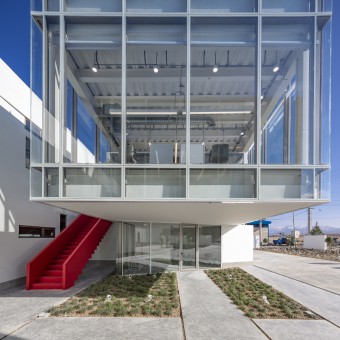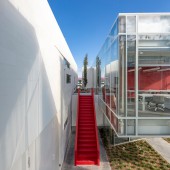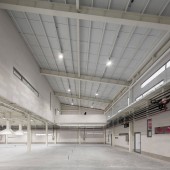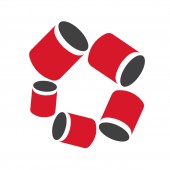Shamim Polymer Factory by Davood Boroojeni |
Home > Winners > #118679 |
 |
|
||||
| DESIGN DETAILS | |||||
| DESIGN NAME: Shamim Polymer PRIMARY FUNCTION: Factory INSPIRATION: Factors such as the desired spatial quality, local architecture, climate and exposed usage of materials have been considered in the project design. We believe that beautiful innovative useful architecture of Shamim Polymer factory is the result of using the above mentioned factors in the project simultaneously. UNIQUE PROPERTIES / PROJECT DESCRIPTION: This project seeks to increase sense of connecting spaces to improve the quality of life of factory workers. The concept of this complex took place in two outdoor void spaces perpendicular to each other. The geometry of these void spaces makes separation of different parts possible and acts as a middle courtyard for connecting different areas with each other. Human dimensions, open air, light and shadow, green space and color increase the sense of middle courtyard. OPERATION / FLOW / INTERACTION: One of our primary goals of design was to expose materials. We believe that the uses of exposed materials not only creates an industrial feel in the spaces, also makes less harm to the environment. Structures are made of steel, floors are made of concrete, walls are made of prefabricated concrete blocks, glass, prefabricated concrete panels, and stairs are made of in-site concrete without any other materials being added. PROJECT DURATION AND LOCATION: The project started in May 2019 and finished in November 2020. The project is located in a small industrial town in Alborz province of Iran. FITS BEST INTO CATEGORY: Architecture, Building and Structure Design |
PRODUCTION / REALIZATION TECHNOLOGY: In Iran there have been specific patterns for organizing building plans from the past. The middle courtyard and the cruciform axes are two important patterns in Iranian architecture. It is believed that the prediction of these two patterns in the architectural design of this project is an attempt to revitalize these two Iranian architectural methods in industrial uses. SPECIFICATIONS / TECHNICAL PROPERTIES: The project proposal is related to a factory for the production of polymeric materials. The factory has a production, office and research department. The project land is approximately square like (60 meters long and 50 meters wide) is limited to the neighbor in the north and west and to the street in the south and east. This land with an area of three thousand square meters is located in a small industrial town in Alborz province of Iran. TAGS: Industrial Architecture, Factory, Iran, Middle Courtyard, Concrete, Office, Cruciform Axes, Green Roof, Exposed Materials, Davood Boroojeni RESEARCH ABSTRACT: In this project, design methodology used quantitative and qualitative. The paramount goals of this project focused on best achieving, Appropriate Functionality, Provision of Desired Spatial Quality, Restoration of Middle Courtyard and Consumption Reduction of Energy and Construction Material. It is to note that such data gathering and assessment techniques utilized as field observation, review of architectural standards, identification of employer needs, review of relevant historical background, technical analysis of construction material, and last but not the least an assessment on the region climate. CHALLENGE: The most important challenge in designing industrial uses is the proper separation of different work spaces. For this purpose instead of a wall we used space to separate different parts. The middle courtyards prediction helped to separate various parts of the factory properly. Other challenge was the possibility of leaving this middle courtyard abandoned. To meet this challenge we increased the spatial quality of the middle courtyard by observing human dimensions and considering open air for it and predicting the light and shadow play and green space and color. ADDED DATE: 2021-02-16 04:31:12 TEAM MEMBERS (9) : Principal Architect: Davood Boroojeni, Design Team: Saba Ammari, Design Team: Hamed Kalateh, Civil Engineer: Bardia Khafaf, Mechanical Engineer: Hamidreza Nikzad, Mechanical Engineer: Mohsen Jafari, Electrical Engineer: Amir Salamat, Executive Team: Barbod Mokhtari and Executive Team: Emran Nazarian IMAGE CREDITS: All photos : Photographer Parham Taghioff |
||||
| Visit the following page to learn more: http://bit.ly/3pBIH8o | |||||
| AWARD DETAILS | |
 |
Shamim Polymer Factory by Davood Boroojeni is Winner in Architecture, Building and Structure Design Category, 2020 - 2021.· Read the interview with designer Davood Boroojeni for design Shamim Polymer here.· Press Members: Login or Register to request an exclusive interview with Davood Boroojeni. · Click here to register inorder to view the profile and other works by Davood Boroojeni. |
| SOCIAL |
| + Add to Likes / Favorites | Send to My Email | Comment | Testimonials | View Press-Release | Press Kit | Translations |
Did you like Davood Boroojeni's Architecture Design?
You will most likely enjoy other award winning architecture design as well.
Click here to view more Award Winning Architecture Design.








